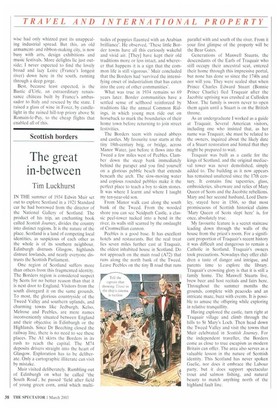Scottish borders
The great in-between
Tim Luckhurst
IN THE summer of 1934 Edwin Muir set out to explore Scotland in a 1921 Standard car he had borrowed from the director of the National Gallery of Scotland. The product of his trip, an enchanting book called Scottish Journey', divides the country into distinct regions. It is the nature of the place. Scotland is a land of competing local identities, as suspicious of each other as the whole is of its southern neighbour. Edinburgh distrusts Glasgow, highlands distrust lowlands, and nearly everyone distrusts the Scottish Parliament.
One region of Scotland suffers more than others from this fragmented identity. The Borders region is considered suspect by Scots for no better reason than that it is next door to England. Visitors from the south disregard it on the same grounds. To most, the glorious countryside of the Tweed Valley and southern uplands, and charming towns like Jedburgh. Kelso, Melrose and Peebles, are mere names inconveniently situated between England and their objective in Edinburgh or the Highlands. Since Dr Beeching closed the railway line, there is no need to see these places. The Al skirts the Borders in its rush to reach the capital. The M74 deposits drivers straight into the heart of Glasgow. Exploration has to be deliberate. Only a cartographic illiterate can visit by mistake.
Muir visited deliberately. Rumbling out of Edinburgh on what he called 'the South Road', he passed 'field after field of young green corn, amid which multi tudes of poppies flaunted with an Arabian brilliance'. He observed, 'These little Border towns have all this curiously wakeful and vivid air. [They] have kept their old traditions more or less intact, and wherever that happens it is a sign that the common life is still vigorous.' Muir concluded that the Borders had 'survived the intensifying onset of industrialism that has eaten into the core of other communities'.
What was true in 1934 remains so 69 years later. Border communities have a settled sense of selfhood reinforced by traditions like the annual Common Ridings, in which young men ride out on horseback to mark the boundaries of their home town before returning to join street festivities.
The Borders teem with ruined abbeys and castles. My favourite tour starts at the tiny 18th-century brig, or bridge, across Manor Water, just before it flows into the Tweed a few miles west of Peebles. Clamber down the steep bank immediately behind the parapet and you find yourself on a glorious pebble beach that extends beneath the arch. The slow-moving water and copious rounded pebbles make it the perfect place to teach a boy to skim stones. It was where I learnt and where I taught my ten-year-old son.
From Manor walk east along the south bank of the Tweed. From the wooded shore you can see Neidpath Castle, a classic peel-tower tucked into a bend in the river, its walls still scarred by the onslaught of Cromwellian cannon.
Peebles is a good base, It has excellent hotels and restaurants. But the real treat lies seven miles further east at Traquair, the oldest inhabited house in Scotland. Do not approach on the main road (A72) that runs along the north bank of the Tweed. Leave Peebles on the tiny B road that runs
parallel with and south of the river. From it your first glimpse of the property will be the Bear Gates.
Generations of Maxwell Stuarts, the descendants of the Earls of Traquair who still occupy their ancestral seat, entered their home through this impressive portal, but none has done so since the 1740s and nor will you. They were sealed shut when Prince Charles Edward Stuart (Bonnie Prince Charlie) fled Traquair after the Jacobite uprising was crushed at Culloden Moor. The family is sworn never to open them again until a Stuart is on the British throne.
As an undergraduate I worked as a guide at Traquair. Several American visitors, including one who insisted that, as her name was Traquair, she must be related to the owners, inquired about the likely date of a Stuart restoration and hinted that they might be prepared to wait.
Traquair was built as a castle for the kings of Scotland, and the original mediaeval tower was never demolished, simply added to. The building as it now appears has remained unaltered since the 17th century. It contains fine tapestries, glass, embroideries, silverware and relics of Mary Queen of Scots and the Jacobite rebellions. Mary and her second husband, Lord Darnley, stayed here in 1566, so that most promiscuous of Scottish historical claims 'Mary Queen of Scots slept here' is, for once, absolutely true.
My favourite feature is a secret staircase leading down through the walls of the house from the priest's room. For a significant proportion of Traquair's recent history it was difficult and dangerous to remain a Catholic in Scotland. Traquair's owners took precautions. Nowadays they offer children a taste of danger and intrigue, and parents time to explore the library. Traquair's crowning glory is that it is still a family home. The Maxwell Stuarts live, brew beer and host recitals and fairs here. Throughout the summer months the grounds, complete with peacocks and an intricate maze, buzz with events. It is possible to amuse the offspring while exploring in relative tranquillity.
Having explored the castle, turn right at Traquair village and climb through the hills to St Mary's Loch. Then head down the Tweed Valley and visit the towns that Muir celebrated in Scottish Journey, For the independent traveller, the Borders come as close to true escapism as modern Britain can offer. The area also serves as a valuable lesson in the nature of Scottish identity. This Scotland has never spoken Gaelic, nor does it embrace the Labour party, but it does support spectacular trout and salmon fishing, and natural beauty to match anything north of the highland fault line.


















































































 Previous page
Previous page